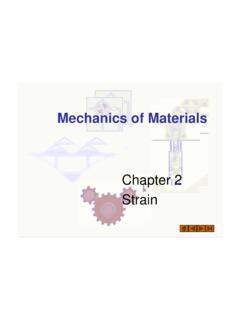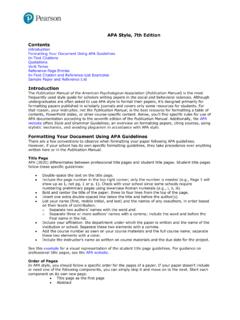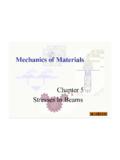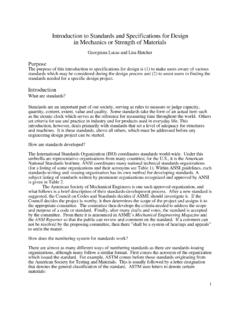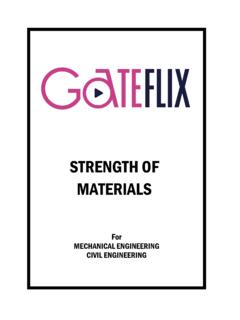Transcription of Mechanics of Sheet Metal Forming - College of Engineering ...
1 Mechanics of SheetMetal FormingMechanics of SheetMetal FormingZ. MarciniakThe Technical University of Warsaw, DuncanThe University of Auckland, New HuThe University of Michigan, USAOXFORD AMSTERDAM BOSTON LONDON NEW YORK PARISSAN DIEGO SAN FRANCISCO SINGAPORE SYDNEY TOKYOB utterworth-HeinemannAn imprint of Elsevier ScienceLinacre House, Jordan Hill, Oxford OX2 8DP225 Wildwood Avenue, Woburn, MA 01801-2041 First published by Edward Arnold, London, 1992 Second edition published by Butterworth-Heinemann 2002 Copyright 2002 Hu, Z. Marciniak, DuncanAll rights reservedThe right of Hu, Z. Marciniak and Duncan to be identified as the authors of this work has beenasserted in accordance with the Copyright, Designs and Patents Act 1988 All rights reserved.
2 No part of this publicationmay be reproduced in any material form (includingphotocopying or storing in any medium by electronicmeans and whether or not transiently or incidentallyto some other use of this publication) without thewritten permission of the copyright holder exceptin accordance with the provisions of the Copyright,Designs and Patents Act 1988 or under the terms of alicence issued by the Copyright Licensing Agency Ltd,90 Tottenham Court Road, London, England W1T for the copyright holder s written permissionto reproduce any part of this publication should be addressedto the publishersBritish Library Cataloguing in Publication DataA catalogue record for this book is available from the British LibraryLibrary of Congress Cataloguing in Publication DataA catalogue record for this book is available from the Library of CongressISBN 0 7506 5300 0 For information on all Butterworth-Heinemann publications visit our website at by Laserwords Private Limited, Chennai.
3 IndiaPrinted and bound in Great BritainContentsPreface to the second editionixPreface to the first editionxiDisclaimerxiiIntroductionxi1 material Tensile Effect of properties on Other mechanical Exercises132 Sheet deformation Uniaxial General Sheet processes (plane stress) Yielding in plane The flow Work of plastic Work hardening Effective stress and strain Exercises273 Deformation of Sheet in plane Uniform Sheet deformation Strain Strain Modes of Effective stress strain The stress Principal tensions or Exercises43v4 Simplified stamping Two-dimensional model of Stretch and draw ratios in a Three-dimensional stamping Exercises595 Load instability and Uniaxial tension of a perfect Tension of an imperfect Tensile instability in stretching continuous Factors affecting the Forming limit The Forming Exercises806 Bending of Variables in bending a continuous Equilibrium
4 Choice of material Bending without Elastic unloading and Small radius The bending Bending a Sheet in a Exercises1067 Simplified analysis of circular The shell Equilibrium Approximate models of Forming Applications of the simple Exercises1168 Cylindrical deep Drawing the Cup Redrawing cylindrical Wall ironing of deep-drawn Exercises127viContents9 Stretching circular Bulging with fluid Stretching over a hemispherical Effect of punch shape and Exercises13510 Combined bending and tension of Stretching and bending an elastic, perfectlyplastic Bending and stretching a strain-hardening Bending a rigid, perfectly plastic Sheet Bending and unbending under Free expansion of a cylinder by internal Forming a cylinder to a square Constant thickness Low-pressure or sequential Exercises163 Appendix A1 Yielding in three-dimensional stress state165 Appendix A2 Large strains: an alternative definition168 Solutions to exercises176 Index205 ContentsviiPreface to thesecond editionThe first edition of this book was published a decade ago; the Preface stated the objectivein the following this book, the theory of Engineering plasticity is applied to the elements of commonsheet Metal Forming processes.
5 Bending, stretching and drawing of simple shapes areanalysed, as are certain processes for Forming thin-walled tubing. Where possible,the limits governing each process are identified and this entails a detailed study oftensile instability in thin the authors knowledge, this is the first text in English to gather together themechanics of Sheet Forming in this manner. It does, however, draw on the earlierwork of, for example, Swift, Sachs, Fukui, Johnson, Mellor and Backofen althoughit is not intended as a research monograph nor does it indicate the sources of themodels. It is intended for the student and the practitioner although it is hoped that itwill also be of interest to the second edition keeps to the original aim, but the book has been entirely rewritten toaccommodate changes in the field and to overcome some earlier deficiencies.
6 ProfessorHu joined the authors and assisted in this revision. Worked examples and new problems(with sample solutions) have been added as well as new sections including one on hydro- Forming . Some of the original topics have been omitted or given in an abbreviated formin recent years, enormous progress has been made in the analysis of Forming of complexshapes using finite element methods; many engineers are now using these systems toanalyse Forming of intricate Sheet Metal parts. There is, however, a wide gulf between thestatement of the basic laws governing deformation in Sheet Metal and the application oflarge modelling packages. This book is aimed directly at this middle ground. At the oneend, it assumes a knowledge of statics, stress, strain and models of elastic deformation ascontained in the usual strength of materials courses in an Engineering degree program.
7 Atthe other end, it stops short of finite element analysis and develops what may be called Mechanics models of the basic Sheet Forming operations. These models are in manyrespects similar to the familiar strength of materials models for bending, torsion etc., inthat they are applied to simple shapes, are approximate and often contain simplifyingassumptions that have been shown by experience to be reasonable. This approach hasproved helpful to engineers entering the Sheet Metal field. They are confronted with anixindustry that appears to be based entirely on rules and practical experience and theyrequire some assistance to see how their Engineering training can be applied to the designof tooling and to the solution of problems in the stamping plant.
8 Experienced Sheet metalengineers also find the approach useful in conceptual design, in making quick calculationsin the course of more extensive design work, and in interpreting and understanding thefinite element simulation results. Nevertheless, users of these models should be aware ofthe assumptions and limitations of these approximate models as real Sheet Metal designscan be much more complex than what is captured by the order in which topics are presented has been revised. It now follows a patterndeveloped by the authors for courses given at graduate level in the universities and tosheet Metal engineers and mechanical metallurgists in industry and particularly in theautomotive field. The aim is to bring students as quickly as possible to the point wherethey can analyse simple cases of common processes such as the Forming of a sectionin a typical stamping.
9 To assist in tutorial work in these courses, worked examples aregiven in the text as well as exercises at the end of each chapter. Detailed solutions of theexercises are given at the end of the text. The possibility of setting interesting problems isgreatly increased by the familiarity of students with computer tools such as spread not part of this book, it is possible to go further and develop animated modelsof processes such as bending, drawing and stamping in which students can investigate theeffect of changing variables such as friction or material properties. At least one packageof this kind is available through Professor Duncan and Professor students and colleagues have assisted the authors in this effort to develop asound and uncomplicated base for education and the application of Engineering in sheetmetal Forming .
10 It is impossible to list all of these, but it is hoped that they will be awareof the authors appreciation. The authors do, however, express particular thanks to sev-eral who have given invaluable help and advice, namely, Atkins, Hosford,F. Wang, J. Camelio and the late R. Sowerby. In addition, others have provided com-ment and encouragement in the final preparation of the manuscript, particularly M. Dingleand R. Andersson; the authors thank them and also the editorial staff at HuAnn Arbor2002xPreface to the second editionPreface to the first editionIn this book, the theory of Engineering plasticity is applied to the elements of commonsheet Metal Forming processes. Bending, stretching and drawing of simple shapes areanalysed, as are certain processes for Forming thin-walled tubing.



